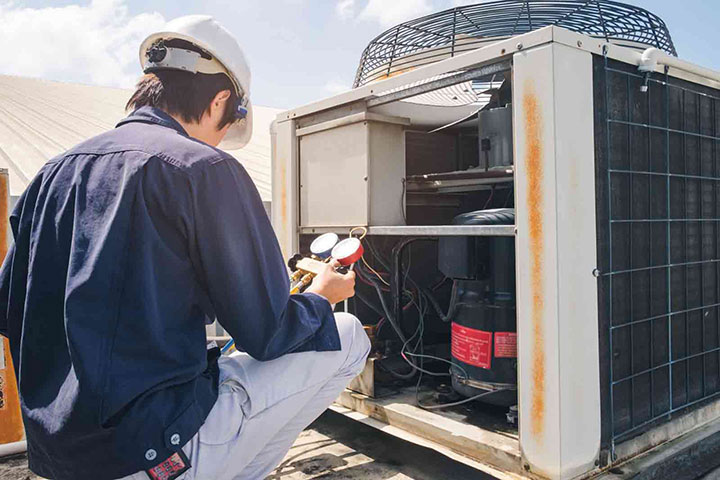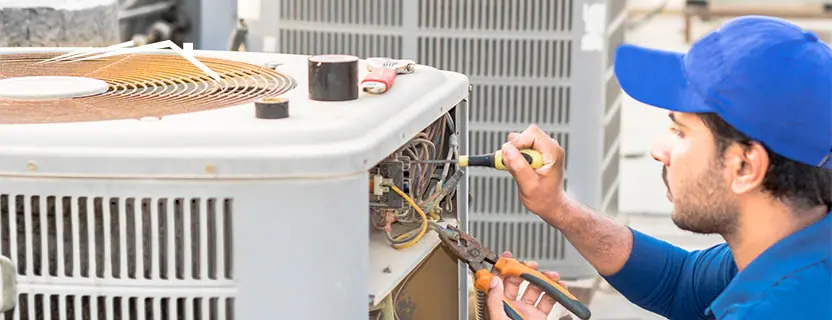Detailed Process Breakdown for heat pump installation ooltewah tn
Detailed Process Breakdown for heat pump installation ooltewah tn
Blog Article
How a Heatpump and Heater Collaborate to Maximize Your Home's Heating Performance
Recognizing just how a heatpump and heating system work with each other is essential for property owners looking for efficient heating options. Each system has its strengths, providing a balanced method to home comfort. The warmth pump stands out in moderate temperatures, while the furnace supplies fast heat throughout extreme cold. This harmony not only lowers power expenses yet likewise boosts the life-span of both appliances. What variables influence this cooperation, and exactly how can homeowners optimize their benefits?
Understanding Warm Pumps: How They Function
Although lots of people may be not familiar with their internal functions, heat pumps play a crucial role in modern heater. These tools operate by moving warmth from one place to another, using the concepts of thermodynamics. In cooler months, a warmth pump extracts warm from the outdoors air, ground, or water, and transfers it inside to heat the living area. Conversely, throughout warmer months, it can turn around the process, functioning as an ac unit by removing warmth from inside to the outside.Heat pumps consist of an evaporator, compressor, condenser, and development shutoff. The cooling agent within the system takes in warmth as it vaporizes at reduced temperature levels and pressures. The compressor after that increases the pressure and temperature of the refrigerant, allowing it to release heat as it condenses. This reliable procedure can greatly reduce power intake contrasted to typical home heating approaches, making heatpump a lasting selection for environment control in homes.
The Function of Furnaces in Home Heating
Furnaces play an important role in home heating by providing a dependable source of heat throughout the chillier months. They operate by creating warmth with combustion or electrical resistance, dispersing it throughout the home through ducts or glowing systems. The performance of a heating system is usually measured by its Yearly Gas Utilization Effectiveness (AFUE) score, which suggests how efficiently the system converts gas into heat.Furnaces can make use of different energy resources, including all-natural gas, propane, electricity, or oil, allowing home owners to choose one of the most suitable choice for their demands. Unlike warm pumps, which may have a hard time in extreme chilly, heaters preserve regular performance, making sure that indoor temperature levels remain comfortable no matter of outdoor problems. In addition, modern heaters typically come equipped with sophisticated modern technology, such as clever thermostats and variable-speed blowers, enhancing their performance and responsiveness. This flexibility makes heating systems an essential element in comprehensive home heating methods.

Advantages of Making Use Of Both Equipments With Each Other
Incorporating the toughness of both heating systems and heatpump can lead to an extra effective and reliable home heating option. Utilizing both systems allows home owners to capitalize on the heat pump's power effectiveness during milder temperature levels while counting on the furnace for more severe cold problems. This double approach can substantially minimize energy prices, as heatpump take in less power than standard heating approaches when temperatures are moderate.Additionally, making use of both systems together can boost comfort degrees in the home. Heat pumps can give constant, also heating, while heaters can rapidly elevate ambient temperatures when required. Furthermore, the assimilation of both systems can extend the life-span of equipment by decreasing wear and tear on each system, as they share the work. Inevitably, property owners can enjoy a well balanced, cost-effective heating remedy that changes flawlessly to varying climate problems, making certain a warm and welcoming home throughout the wintertime months.
How Warm Pumps and Furnaces Enhance Each Various Other
They develop a complementary heating system that optimizes efficiency and comfort when property owners incorporate warmth pumps and heaters. Warmth pumps run by moving warmth from the outdoors air or ground, making them very reliable in modest environments. They succeed throughout milder temperature levels, supplying cost-efficient home heating. Alternatively, heaters produce warm with burning or electrical resistance, supplying solid, instant warmth throughout severe cool conditions.The mix of these two systems enables for dynamic modifications based on temperature variations. Throughout warmer months or milder winter months days, the warmth pump can take the lead, preserving power and lowering costs. As temperatures decline, the heating system can effortlessly engage, ensuring regular heat throughout the home. This synergy not just enhances energy usage however likewise enhances the life-span of both systems, as each system operates within its excellent performance array. With each other, they create a well balanced setting that adjusts to varying climate needs.
Optimizing Performance: Tips for Homeowners
Home owners can improve their home heating effectiveness through numerous useful strategies. Developing a regular upkeep schedule, incorporating smart thermostat modern technology, and executing reliable insulation and sealing remedies are essential actions. These steps not just improve convenience but additionally reduce energy prices.
Regular Upkeep Schedule
To ensure maximum heating effectiveness, developing a normal maintenance timetable is necessary for any home. Property owners should prioritize regular inspections of both heatpump and heaters to determine peak efficiency. This consists of changing air filters every one to three months, as stopped up filters can greatly minimize performance. Additionally, scheduling expert upkeep at the very least yearly allows service technicians to recognize and address prospective problems prior to they intensify. Home owners should also clean up the warm pump's outside system to avoid particles buildup that can hinder airflow. By adhering to a regular maintenance schedule, property owners not only improve their heater' effectiveness however also extend their life expectancy, resulting in higher comfort and decreased energy costs throughout the colder months.
Smart Thermostat Integration
Incorporating a clever thermostat right into a home heating unit can significantly enhance power efficiency, especially as it permits precise control over temperature level settings. These devices can discover the house owner's routine and preferences, instantly changing the temperature level to maximize convenience while reducing energy usage. They can reduce home heating during times when the home is empty, decreasing unneeded usage. Numerous smart thermostats additionally supply real-time power use information, allowing house owners to make enlightened choices about their home heating habits. In addition, remote access by means of mobile phone applications allows customers to change setups from anywhere, making certain the this page home is warm upon return. Generally, wise thermostat integration not just improves comfort but significantly adds to power cost savings and efficiency.
Insulation and Securing Solutions
Smart thermostats play a crucial duty in energy performance, yet their efficiency can be considerably boosted by proper insulation review and securing options. Property owners should prioritize protecting attic rooms, wall surfaces, and floorings to minimize warmth loss. High-grade insulation materials, such as spray foam or fiberglass, can greatly enhance thermal resistance. In addition, sealing gaps around home windows, ducts, and doors protects against cold air infiltration and heat getaway. Weatherstripping and caulking are reliable approaches for attending to these leaks - heat pump service. Normal examinations for air leaks, in addition to making use of blower door tests, can assist determine trouble locations. By purchasing insulation and sealing, house owners can maximize the performance of their furnace, ultimately bring about reduced power intake and lower utility bills
Typical Myths Regarding Warm Pumps and Furnaces
What misunderstandings border heat pumps and heating systems? Many people erroneously think that heatpump are inefficient in chillier environments. Actually, modern-day heatpump are created to operate efficiently even in low temperatures, giving trusted heating throughout wintertime. One more common myth is that heating systems are constantly extra efficient than heat pumps. This depends on the details energy resources and performance scores of the devices in inquiry. Some might likewise believe that making use of both systems all at once is unnecessary, however actually, this mix can maximize home heating effectiveness, specifically during extreme weather condition problems. Furthermore, individuals often assume that heatpump require continuous maintenance, when in fact, they have similar maintenance needs to conventional furnace. By unmasking these misconceptions, home owners can make even more informed decisions concerning their home heating options, eventually resulting in enhanced convenience and energy efficiency in their homes.
Upkeep Considerations for Combined Solutions

Regularly Asked Concerns
Can Heat Pumps Work Efficiently in Extremely Cold Climates?
Heatpump can struggle in exceptionally cool climates due to lowered performance and heat extraction constraints. Improvements in innovation have led to designs created for much better performance in such problems, improving their stability in rough atmospheres.
For How Long Do Warm Pumps and Furnaces Usually Last?
Heat pumps commonly last 15 to 20 years, while furnaces have a life expectancy of 15 to three decades. Normal maintenance can extend their long life, ensuring effective operation and decreasing the need for early replacements.

What Is the Typical Expense of Installing Both Systems?
The typical cost of installing both a heatpump and a heating system generally varies in between $5,000 to $10,000 - heat pump installation ooltewah tn. Variables affecting this price include system size, setup intricacy, and local labor rates
Are There Tax Incentives for Using Energy-Efficient Heating Systems?
Many homeowners inquire concerning tax obligation motivations for energy-efficient heating systems. Various federal and state programs usually provide discounts or credit scores, motivating the adoption of sustainable modern technologies to minimize power intake and advertise ecological responsibility.
Just how Do I Select the Right Dimension Warmth Pump and Furnace?
Picking the best size heat pump and heater includes computing the home's square footage, taking into consideration insulation quality, and examining local environment. Consulting a specialist can guarantee suitable system efficiency and energy performance based upon certain requirements. heat pump service. Understanding exactly how a warm pump and heater work together is necessary for house owners seeking effective home heating remedies. In chillier months, a warm pump extracts warmth from the outside air, ground, or water, and transfers it indoors to warm up the living space. When homeowners incorporate warmth pumps and heating systems, they produce a corresponding home heating system that makes the most of efficiency and comfort. Warm pumps run by transferring warmth from the outdoors air or ground, making them extremely effective in modest environments. Warm pumps can battle in extremely cool climates due to lowered efficiency and heat extraction limitations
Report this page